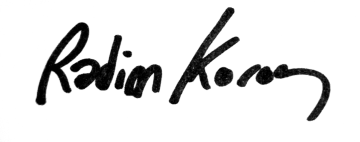NEXT
The abstract of the doctoral dissertation in the field of Fine Arts by Radim Koros
Looking for synergy between the human and the machine in the process of art creation
The dissertation herein is the sequel to my earlier project titled Awry Continuum which I completed during my master’s programme at Jan Matejko Academy of Fine Arts under the supervision of Lech Polcyn, PhD, DSc. The premise for the thesis is my awareness of the misunderstanding deeply rooted in cooperation between a man and a computing device in the process of art creation as it sharply manifested itself during my work on the Awry Continuum project. The word, which serves as the title for this paper, NEXT, is a neologism, which in case of this dissertation shall have the following meaning: accidental, uncontrolled and unknown information which occurs in the electronic circuit processing data. Such information can be the potential source of free will — a conclusion which motivated me in my search for the appropriate approach to the machine. It made me especially aware of how to persevere in being a partner who is capable of conducting a dialogue from the most equal position possible to the techno-electrical “organism”. The Area of research includes all that what is considered as an unpredictable outcome of the machine.
The Introduction starts with the Aristotelean understanding of mimesis, and moves on towards the ideas of André Malraux on metaphysics in art. The attempt to illustrate evolution of the “metaphysical essence” — “the god particle” inherent within the medium itself is made with the help of history. It makes one aware of such particle existence within things of human production and discover the current existence in the viractual reality.(In his 1999 doctoral thesis, Joseph Nechvatal defined the concept of “viractualism” as the mutual 1 relationship between the virtual and the actual (real) environment.)
In the Paintings chapter, the story behind the man and computer cooperation and behind the paintings themselves is revealed by referring to my inspirations. The dichotomy between remediation and hyper-mediation, mentioned by Colin Roswell, presents one of key contributions here.
The chapter titled NEXT is a science-fiction contribution meant to provide better understanding of the computer’s potential to be self-aware. Here we witness certain confusion triggered by the computer’s confrontation with itself. We feel its spiritual degradation all the way to the very first unity, which alludes to the fundamental question by Descartes: What is the first for me?
Further 7 topics are examined in individual chapters of the paper. The ideas of the scientist, Raymond Kurtzweil and of the theoretician, Frank Popper as well as of artists like Roy Ascott, Stahl Stencil or Rebeka Allen are discussed. The following hypotheses and arguments are formulated on the basis thereof:
Hypotheses
• The subjective treatment of the medium in the case of artistic creative work is advisable.
• The subjective treatment of the computer is no exception as long as the computer is used as an artistic creative medium.
• Passive, albeit algorithmically valid, processing of information is a fundamental function of a computer. For this reason, information can be taken as its essence.
• An accidental error made by the creator while writing the code creates a hypothetical possibility of creating a space for “independent creative activity” of the computer.
• The “faultlessness” of the use of the artistic medium limits the creator to predictable correctness and eliminates the freedom of creation.
• Error, gibberish, without succumbing to paraphrasing, creates an appearance of mystery and can carry all appearances of the absolute, which, by its very limited nature, also eludes paraphrasing procedures.
• If the error in its elusiveness remains indistinguishable from the absolute, it cannot be said to be or denied.
Argument
The subjective treatment of the medium, understood as the opposite of the instrumental treatment, is a condition underlying all artistic creativity. Understanding the subjectivity of the medium and taking it into account, creating a space for dialogue with the medium in the creative process seems to be necessary in every artistic creation.
The practical part adopts two approaches
• The pure painting process based on the unknown phenomenon of reality. It adopts the opposite form to the linear type of thinking, namely the spherical. This notion is well cached in the words of a renaissance man, Glen River. The need for “The Answer” is replaced by many answers appropriate to the governing dynamics of the particular perspective “Field”. When painting, I balance between abstract and figural forms, deriving from the fact of living in a space which can be located somewhere between virtual and actual reality. The painting process leans towards the viractual reality inspired paintings.
• Another approach follows the rationale behind the first one. However, some fundamental changes occur in the evolution of a particular painting when It is served to the computer which processes a transform algorithm based on random numbers. In order to make it impossible to predict any output. The result provides inspiration for further work on that canvas.
